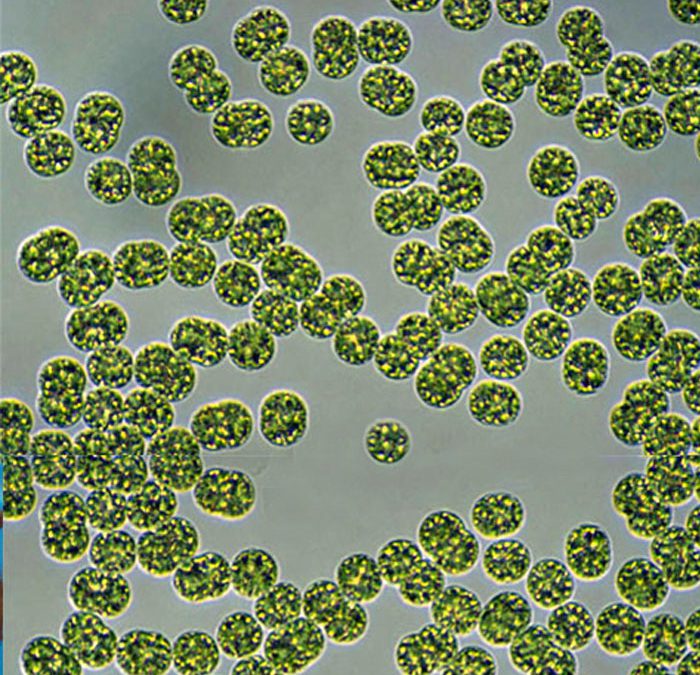
by Rick O'Connor | Oct 25, 2024
In the first article of this series, we discussed whether viruses were truly living organisms. Well, bacteria truly are. They possess all eight characteristics of life but differ from other forms of life in that they lack a true nucleus. Their genetic material just exists in the cytoplasm. This difference is large enough to place them in their own kingdom – Monera.
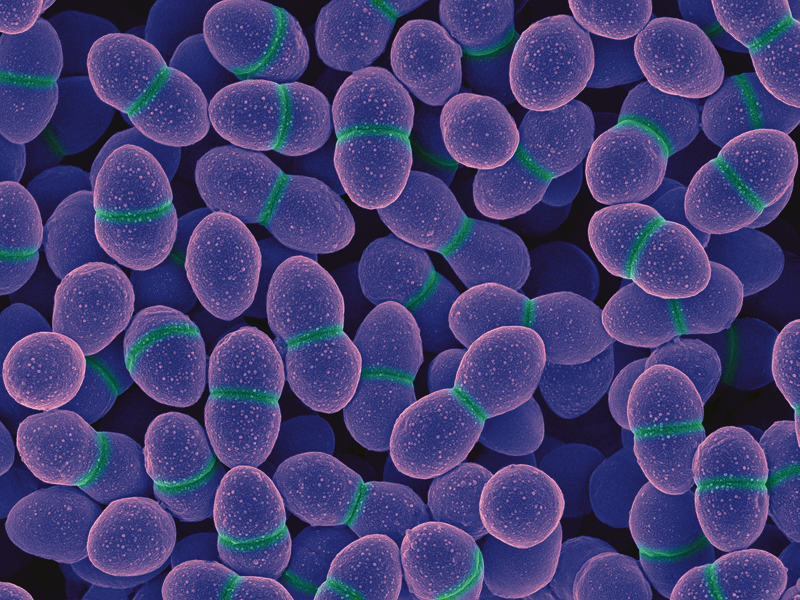
The spherical cells of the “coccus” bacteria Enterococcus.
Photo: National Institute of Health
Bacteria are single celled creatures, though some “hook” together to form long chains. A single cell will average between 5-10 microns in size. This is much larger than a virus but smaller than many eukaryotic cells (those that possess a nucleus).
To further classify bacteria microbiologists will conduct a gram-stain test. Placing a cultured sample of bacteria on a slide, you “bath” them in what is called Gram-stain. Under the microscope the bacteria that appear “pink” are called gram negative, those that appear “purple” are gram positive. Thus, all bacteria can be quickly grouped into those that are gram negative and those that are gram positive.
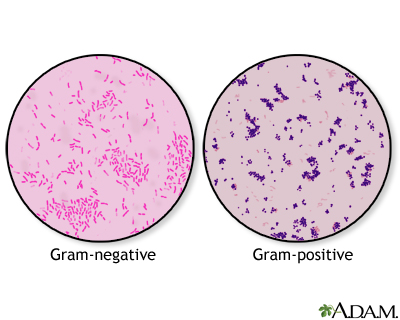
After staining, gram negative bacteria appear pink in color; gram positive are purple.
Image: University of Florida
The next level of classification focuses on the shape of their cells. Those that are “rod-shaped” are called bacillus and often have the term in their name – such as Lactobacillus the bacteria found in milk that makes milk smell sour as their populations grow. The “sphere-shaped” bacteria are called coccus – such as Streptococcus (the bacterium that causes strep throat) and Enterococcus (the fecal bacterium used for monitoring water quality in marine waters). And the third group are “spiral-shaped” and are called spirillum – such as Campylobacter and Helicobacter both are human pathogens.
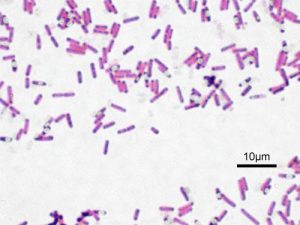
The rod-shaped bacterium known as bacillus.
Image: Wikipedia.
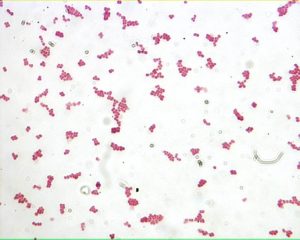
The bacterium known as coccus.
Image: Loyola University
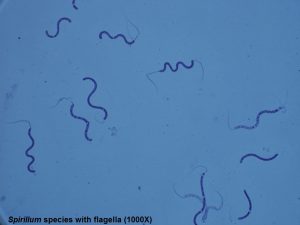
The bacterium known as spirillum.
Image: Lake Superior College.
Bacteria are very abundant in the marine and estuarine waters of the Gulf of Mexico. They can be found floating in the water column, on the surface of the sediment, beneath the surface of the sediment, and on the bodies of marine organisms. When we think of bacteria we think of “dirty” conditions and disease, but many bacteria provide very important ecological benefits to the marine ecosystem and are “good” members of the community.
One important role some bacteria play is the conversion (“fixing”) of nutrients. Animals release toxic waste when they defecate and urinate. One of these is ammonia. Ammonia can bond with oxygen depleting the body of this needed element. Nitrogen fixing bacteria can convert toxic ammonia released into the environment into nitrite. Then another group of nitrogen fixing bacteria will convert nitrite into nitrate – a needed nutrient for plants, and eventually the entire food chain.
Some bacteria are excellent decomposers. When plants and animals die we say they “decay”. What is actually happening is the decomposing bacteria are converting nutrients in their bodies to forms that are usable by living organisms. One byproduct of this decomposition process is hydrogen sulfide – which smells like rotten eggs. In biologically productive ecosystems – like swamps and marshes – the smell of hydrogen sulfide is strong – often called “swamp gas”. It is the smell of nutrient conversion and much needed. Though in high concentrations, hydrogen sulfide is toxic as well – there needs to be a balance. We see this same process happenings when we compost food waste to form fertilizers for our gardens.
One place where the smell of sulfur is very strong is near volcanic vents. If you have been to Yellowstone, or a volcano, the smell is very evident. There are what are termed “extreme bacteria” who can live in these very hot, almost toxic, environments. Just as plants take water and carbon dioxide and convert this to sugar in the process of photosynthesis, bacteria can convert toxic forms of sulfur into usable carbohydrates for other living organisms. In the 1970s marine scientists discovered thermal vents on the bottom of the ocean. These hot “chimneys” spew black clouds of smoke into the water column. Approaching these chimneys carefully they found water temperatures between 700-800°F! Living close to these chimneys they found communities of worms, shrimps, fish, and crabs. The walls of the chimneys are actually composed of sulfur fixing bacteria that are converting volcanic minerals and compounds into sugars in a process called chemosynthesis – which supports these deep-sea communities.
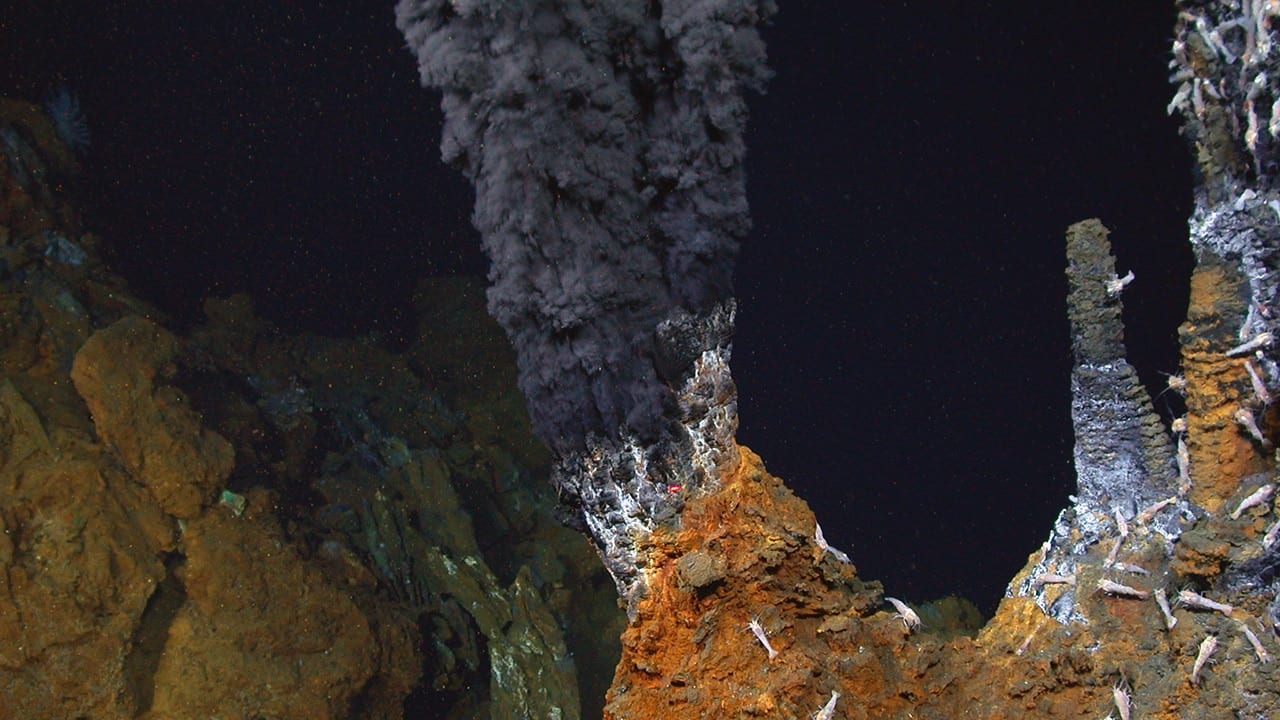
The black smokers – hydrothermal vents – found on the ocean floor.
Photo: Woodshole Oceanographic Institute.
Of course, there are more familiar forms of bacteria that cause disease. Called pathogens – they can be problems for all marine life and sometimes humans. Fecal bacteria associated with human waste are not toxic in themselves at low concentrations. However, if their numbers increase (due to a sewage spill, etc.) these, and other possible pathogenic human bacteria, can be a human health issue. The Florida Department of Health monitors the fecal bacteria levels weekly at beaches where humans like to swim. High concentrations will require the department to issue health advisories. We know that all sorts of bacteria begin to replicate quickly in warmer conditions. This can be a problem with seafood that is not kept cold enough before serving. There are federal regulations on what temperatures commercially harvested seafood must be kept in order to be served or sold to the public. Federal and state agencies can monitor the temperatures of stored seafood as it moves from the fishing vessel to the table. But they cannot monitor it from your fishing rod to your table – that responsibility will fall on you. Pathogenic bacteria is the primary reason we refrigerate and/or freeze much of our food.
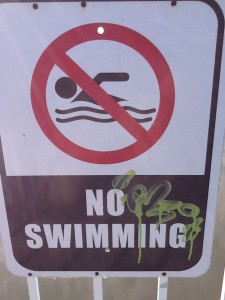
Closed due to bacteria.
Photo: Rick O’Connor
Though bacteria in general have a bad name, many species are not harmful to us and are a major player in the health of our estuarine and marine communities.
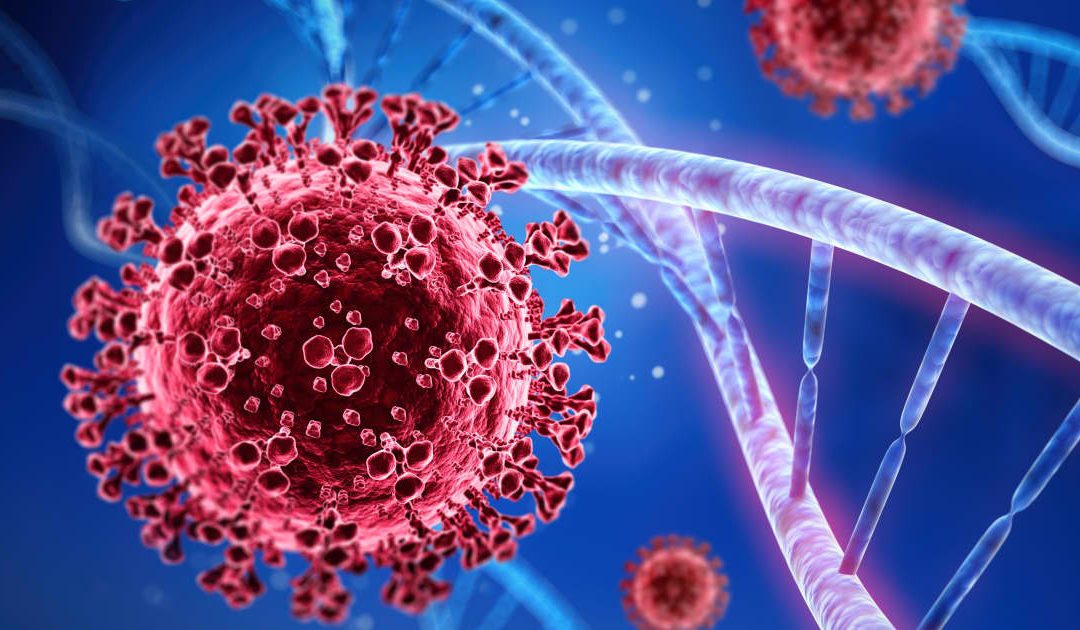
by Rick O'Connor | Oct 18, 2024
We are going to begin this series of articles with a “creature” that some do not consider alive – viruses. While studying marine science in college, and my early days as a marine science educator, there was a debate as to whether viruses were actually alive and should be included in a biology course. A quick glance at the textbooks of the time shows they were often omitted – though they were included in my microbiology class. Why were they omitted? Why did some consider them “non-living creatures”?
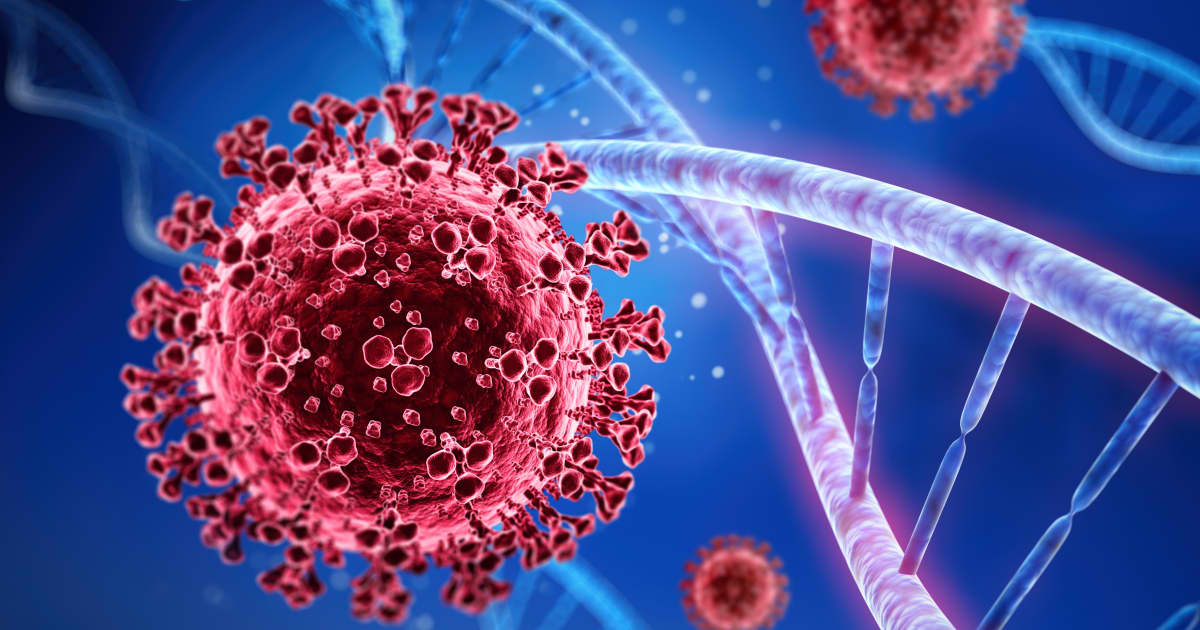
The coronavirus next to a strand of DNA.
Image: Florida International University.
Well, we always began biology 101 with the characteristics of life. Let’s scan these characteristics and see where viruses fit.
- Made of cells. This is not the case for viruses. A typical cell will include a cell membrane filled with cytoplasm and a nucleus, which is filled with genetic material (chromosomes containing DNA and RNA). An examination of a virus you will find it is either DNA or RNA encapsulated in a protein coat. It is “nucleus-like” in nature. Most cells run between 10-20 microns in size. A typical nucleus within a mammal cell will run between 5-10 microns. A typical virus would be 0.1 microns – these are tiny things – MUCH smaller than a cell.
- Process energy. Nope – they do not. Most cells utilize energy during their metabolism. Viruses do not do this.
- Growth and development. Nope again. They “spread”, which we discuss in a moment, but they do not grow. We are now 0-3.
- Homeostasis. Homeostasis is the movement of material and environmental control to remain stable – and viruses do not do this.
- Respond to stimuli. Yes… here is one they do. Studies show that viruses do respond to their chemical and physical environment.
- Metabolism. As mentioned above, this would be a no.
- Adaptation. Studies show that through very rapid reproduction they can adapt to the changing environment they are in.
- Reproduce. This is a sort of “yes/no” answer. They do reproduce (as we say – “spread”) but they do not do this on their own. They invade the nucleus within the cells of their host and replace their genetic material with that of the host creature. Then, during cell replication within the host, new viruses are produced and “spread”.
So, you can see why there is a debate. Of the eight common characteristics of life, viruses possess only three – and one of those can only be achieved with the assistance of a host creature. Now the question would be – do be labeled as a “creature” do you need ALL eight characteristics of life? Or only a few? And if only a few – how many? Because of this most biologists do not consider them alive.
During one class when we were discussing this a student made a comment – “don’t we KILL viruses? If so, then it must be alive first”. Point taken – and we should understand the phrase “kill a viruses” does not mean literally killing. It is a phrase we use. Though some argue we do kill viruses and thus…
Another point we could make here is that all life on the planet has been classified using a system developed by the Swedish botanist Carlos Linnaeus. Each creature is placed in a kingdom, then phylum, class, order, family, genus, and eventually a species name is given. We “name” the creature using its genus and species name – Homo sapiens for example. We do not see this for viruses.
All that said, both the National Oceanic and Atmospheric Administration and the National Institute of Health indicate the “most common form of life in the sea are viral-like particles” – with over 10 million in a single drop of seawater. We will leave the debate here. Your thoughts?

by Thomas Derbes II | Aug 23, 2024
Oysters are not only powerful filterers, they also provide a home and habitat for many marine organisms. Most of these organisms will fall off while the oysters are being harvested or cleaned, but some will stay behind and can be found inside or outside of your oyster on the half shell. Seeing some of these creatures might give you the “heebie jeebies” about eating the oyster, they are perfectly safe and can either be removed or, in some cases, consumed for luck. These creatures include mud worms (Polydora websteri), “pea crabs” (Pinnotheres ostreum or Zaops ostreus), and “mud crabs” (Panopeus herbstii, Hexapanopeus angustifrons or Rhithropanopeus harrisii).
Mud Worms (Polydora websteri)
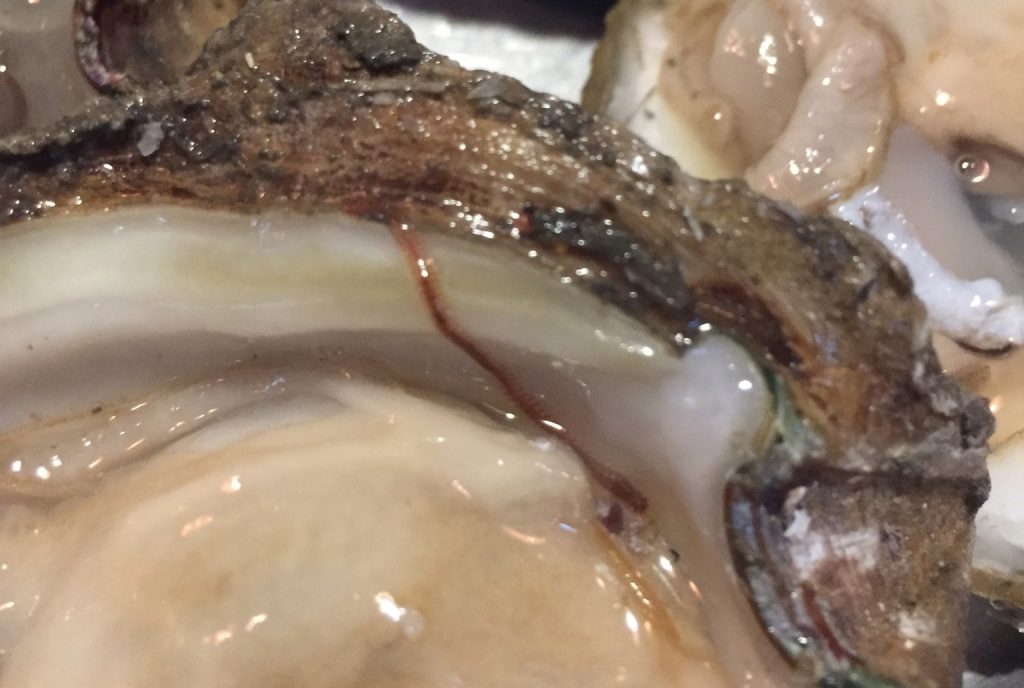
A Mud Worm in an Oyster – Louisiana Sea Grant
One of the more common marine organisms you can find on an oyster is the oyster mud worm. These worms are typically red in color and form a symbiotic relationship with the oyster. Mud worms can be found in both farmed and wild harvest oysters throughout the United States. These worms will typically form a “mud blister” and emerge when the oyster has been harvested. Even though the worms look menacing and unsightly, they are a sign of a fresh harvest and a good environment. Mud worms do not pose any threat to humans and can be consumed.
If you find a mud worm on your next oyster and are still unsure, just simply remove the worm and dispose of it. Dr. John Supan, retired professor and past director of Louisiana Sea Grant’s Oyster Research Laboratory on Grand Isle, mentioned in an article that oyster mud worms “are absolutely harmless and naturally occurring,” and “if a consumer is offended by it while eating raw oysters, just wipe it off and ask your waiter/waitress for another napkin. Better yet, if there are children at the table, ask for a clear glass of water to drop the worm in. They are beautiful swimmers and can be quite entertaining.”
“Pea Crabs” (Pinnotheres ostreum or Zaops ostreus)
“Pea Crabs” are in fact two different species of crabs lumped together under one name. Pea crabs include the actual pea crab (Pinnotheres ostreum) and the oyster crab (Zaops ostreus). These crabs are so closely associated with oysters that their species name contains some form of the Latin word “ostreum” meaning oyster! Pea crabs are known as kleptoparasites and will embed themselves into the gills of an oyster and steal food from the host oyster. Even though they steal food, they seem to pose no threat to the oyster and are a sign of a healthy marine ecosystem.

A Cute Little Pea Crab – (C)2013 T. Michael Williams
Pea crabs are soft-bodied and round, giving them the pea name. Pea crabs can be found throughout the Atlantic coast, but are more concentrated in coastal areas from Georgia to Virginia. While they might look like an alien from another planet, they are considered a delicacy and are typically consumed along with the oyster. If you are brave enough to slurp down a pea crab, you might just be rewarded with a little luck. According to White Stone Oysters, “historians and foodies alike agree that finding a pea crab isn’t just a small treat, it’s also a sign of good luck!”
“Mud Crabs” (Panopeus herbstii, Hexapanopeus angustifrons or Rhithropanopeus harrisii)
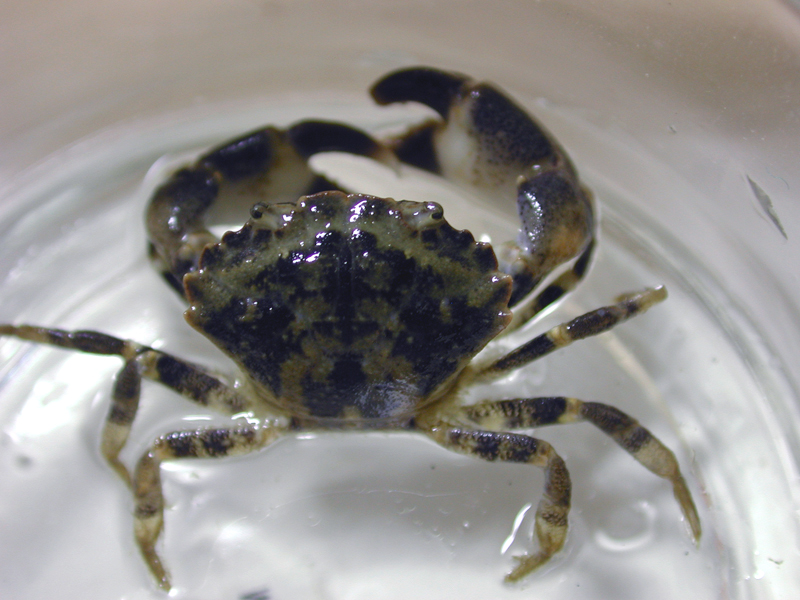
Smooth Mud Crab – Florida Shellfish Lab
Just like pea crabs, “mud crabs” is another name for two different species of crabs commonly found in oysters. These crabs, the Harris Mud Crab (Rhithropanopeus harrisii), Smooth Mud Crab (Hexapanopeus angustifrons), and the Atlantic mud crab (Panopeus herbstii) to name just a few, reach a maximum size of 2 to 8 centimeters and are hard-bodied, unlike the pea crabs. Mud crabs can survive a wide range of salinities, but need cover to survive as these crabs are common prey for most of the oyster habitat dwellers, such as catfish (Ariopsis felis), redfish (Sciaenops ocellatus), and sheepshead (Archosargus probatocephalus). These crabs are not beneficial to an oyster environment as they will seek out young oysters and consume them by breaking the shell with their strong claws. If you find a mud crab in your oyster, this is one to dispose of before consuming. However, these crabs typically live on the outside of an oyster and are typically only found when you buy a sack of oysters and do not have an effect on the quality of the oyster.
Don’t Be Afraid
Hopefully this article has helped shed some light on the creatures you might experience when shucking or consuming oysters. Here is a helpful online tool to help identify some marine organisms associated with clam and oyster farms (Click Here). While most of the organisms can be consumed, we recommend the mud crabs be disposed of due to their hard shells. Remember, some of these organisms can bring you luck and with college football season around the corner, some of us might need all the luck we can get! Bring on the pea crabs!
References Hyperlinked Above
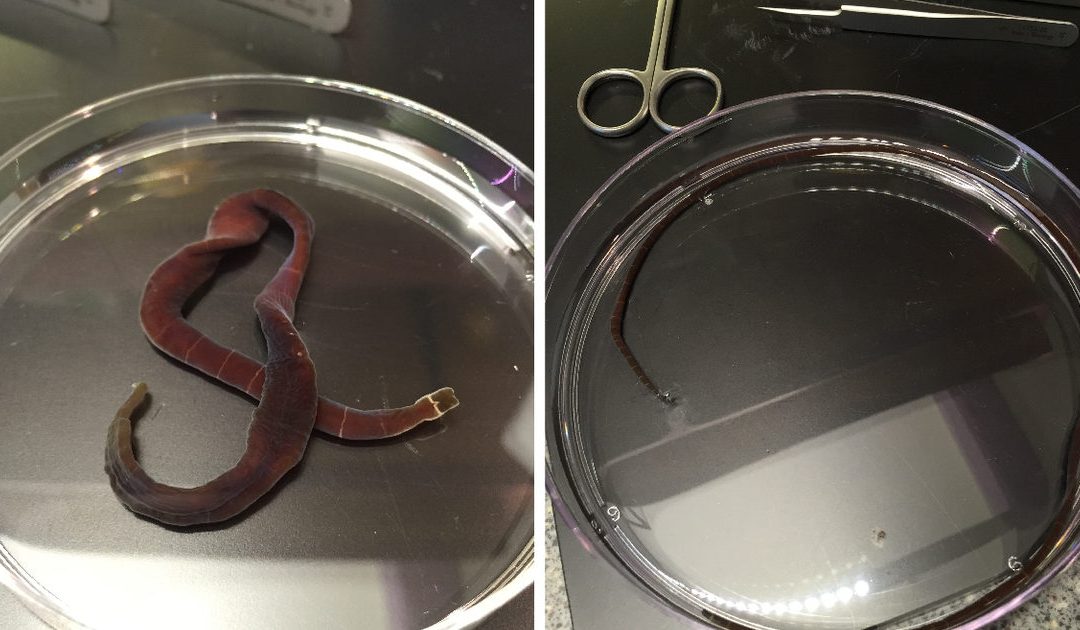
by Rick O'Connor | Aug 10, 2024
I bet that for most of you, this is not only a worm you have never seen – it is a worm you have never heard of before. I learned about them first in college, which was almost 50 years ago, and have never seen one. But, other than the earthworm, the world of worms is basically hidden from us.
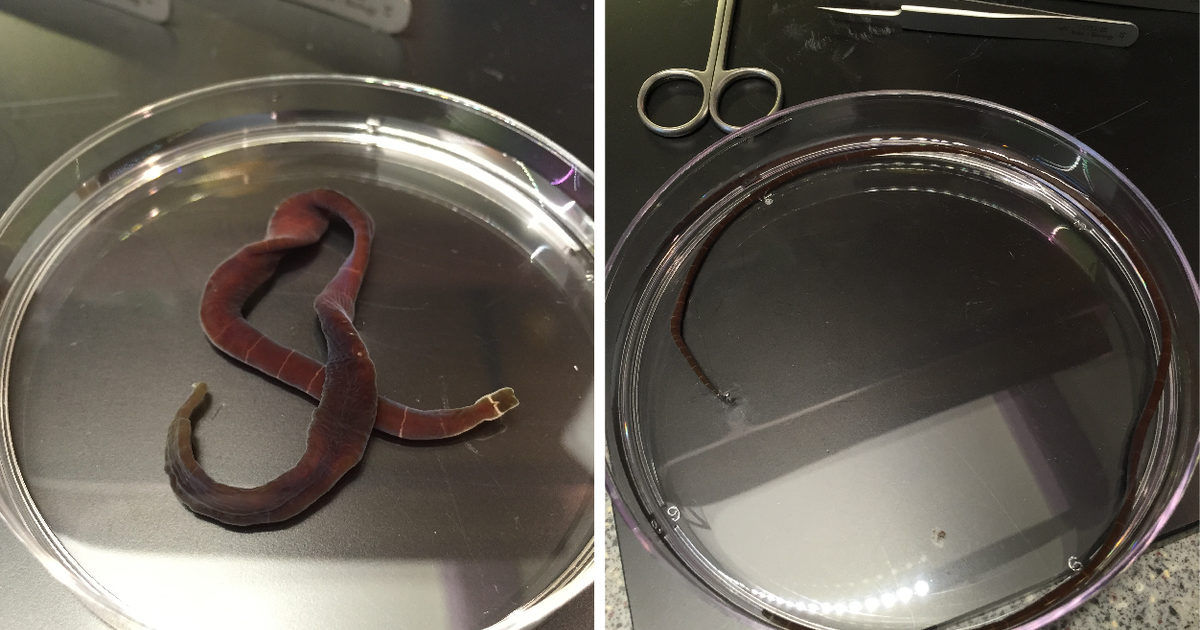
A nemertean worm.
Photo: Okinawa Institute of Science
Nemerteans are a group of about 1300 species in the Phylum Nemertea and are often called ribbon or proboscis worms. They do possess a proboscis used to capture prey. Most are marine and live on the bottom both near the beach and a great depth. They are more temperate than tropical and do have a few parasitic forms.
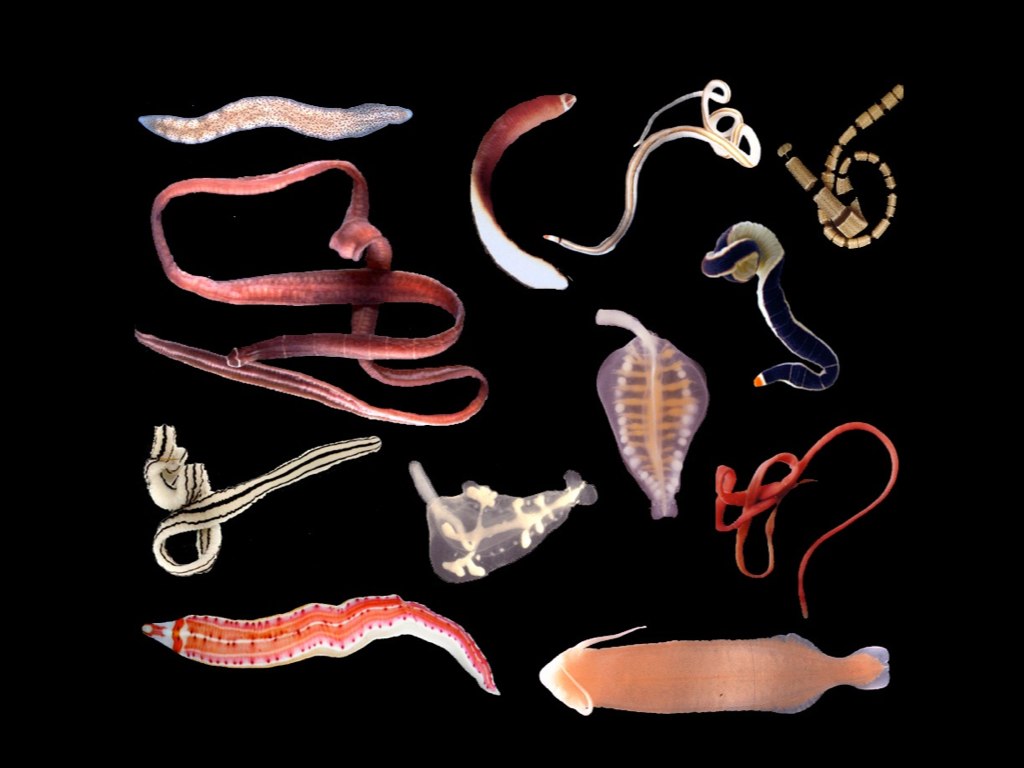
Adult Nemertea Worms – Terra C. Hiebert, PhD, Oregon University
In appearance they resemble flatworms but are larger and more elongated. Most are less than 20cm (8in) but some species along the Atlantic coast can reach 2m (7ft). The head end can be lobed or even spatula looking. Some species are pale in color and others quite colorful. Most nemerteans move over the substrate on a trail of slime produced by their skin. Some species can swim.
As mentioned, the proboscis is used to capture prey. It is a tube-like structure held in a sac near the head. When prey is detected, they can launch the proboscis out and over the victim. Sticky secretions help hold on to the prey while they ingest. Many species are armed with a stylet, dart, that is attached to the proboscis and is driven into the prey like a spear. From there toxins, secreted from the base of the proboscis are injected into the prey.
For many species the proboscis is connected to the digestive tract via a tube, there is no true mouth, but they do possess an anus. They are all carnivorous and feed on a variety of small living and dead invertebrates. Their menu includes annelid worms, mollusk, and crustaceans.
Nemerteans do possess a brain and most find their prey using chemoreception, though some species must literally bump into their prey to find it. They have multiple eyes that can detect light, and, like the true flatworms, they are negatively phototaxic. They are nocturnal by habitat and is probably why most of us have never seen one.
Many nemerteans, particularly the larger ones, have a habit of fragmenting when irritated, creating new worms. Most species have separate sexes and fertilization of the gametes is external (fertilization occurs in the environment).
Nemerteans are an interesting group of semi-large, sometimes toxic, hunters who prowl through the marine waters at night hunting prey. Seen by few, maybe one evening, while exploring or floundering, you may see one.
In Part 3 we will begin to explore a group of worms that are more round than flat. The Gastrotrichs.
Reference
Barnes, R.D. (1980). Invertebrate Zoology. Saunders Publishing. Philadelphia PA. pp. 1089.
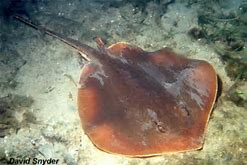
by Rick O'Connor | Aug 10, 2024
I was recently conducting a survey for diamondback terrapins from my paddleboard in a small estuarine lagoon within the Pensacola Bay System. Even if we do not find our target species during these surveys – I, and our volunteers, see all sorts of other cool wildlife. On this trip I was treated to nesting osprey, a kingfisher, large blue crabs, and even a swimming eel. But one neat encounter was the numerous stingrays.

The Atlantic Stingray is one of the common members of the ray group who does possess a venomous spine.
Photo: Florida Museum of Natural History
They were lying in the sand and grassbeds, lots of them, and they all seemed to be of one species – the Atlantic stingray. My brain immediately went to “breeding season”, but when I checked the literature, I found that it was not breeding season, but pupping season – the babies were being born.
Atlantic Stingray (Dasyatis sabina) are true stingrays in the family Dasyatidae. This means they do possess the replaceable serrated venomous barb that makes these animals so famous. They are one of the smaller members of this family. Females can reach a disk width of two feet while the smaller males will only reach about one foot. Atlantic stingrays are a warm water species, migrating if they need to find suitable temperatures. They have been found in water as deep as 80 feet but are more common in the warmer shallower waters near shore. They are very common in our estuaries and being euryhaline (they tolerate a large range of salinity), are found in freshwater systems. There is a population that lives in the St. Johns River. Atlantic stingrays feed on a variety of benthic invertebrates and have special cells in the nose to detect the weak electric fields their prey give off while buried in the sediment. They also like to bury in the sand to ambush prey as they move by.
Breeding occurs in the fall. The smaller males possess two modified fins called claspers connected to their anal fins that are used to transfer sperm to the female. The males have modified teeth they can use to bite the fins of the females. They do this to hold on and make sperm transfer more successful.
The females do not begin to ovulate until spring. So, though they receive the sperm in the fall, fertilization does not occur until the spring. Instead of laying eggs, as some rays and skates do, baby Atlantic stingrays develop within the mother. This is not the same as mammals, who produce a placental to feed the developing young, but more like an internal egg with no hard shell. The embryo is attached to, and feeds from, a yolk sac. Gestation takes about 60 days at which time the yolk sac is depleted, and the young must emerge. Birth usually occurs in late July and early August, and each female will produce 1-4 small pups whose disk are about 10cm (4in.) wide. It was this birthing/pupping period I witnessed.
I returned the following day to search for terrapins and the number of stingrays was significantly fewer. It may be that the birthing process is fast, and the adults leave the coves afterwards. It may have been because that day was the day Hurricane Debby was making landfall east of us and the water levels were abnormally high – something the rays may have noticed and decided to leave – I am not sure.
I was really hoping to see the young rays swimming around – I did not – but plan to search again soon. Stingrays make many people nervous. I witnessed several adult rays whose tails had been cut off – which is very unfortunate – but they are actually cool creatures and fun to watch while paddleboarding. Maybe I will see a baby soon.
References
Dasyatis sabina. 2023. Florida Museum of Natural History. https://www.floridamuseum.ufl.edu/discover-fish/species-profiles/dasyatis-sabina/.
Johnson, M.R., Snelson Jr., F.F. 1996. Reproductive Life History of the Atlantic Stingray, Dasyatis sabina (Pisces, Dasyatidae), in Freshwater St. Johns River, Florida. Bulletin of Marine Science, 59(1): 74-88.
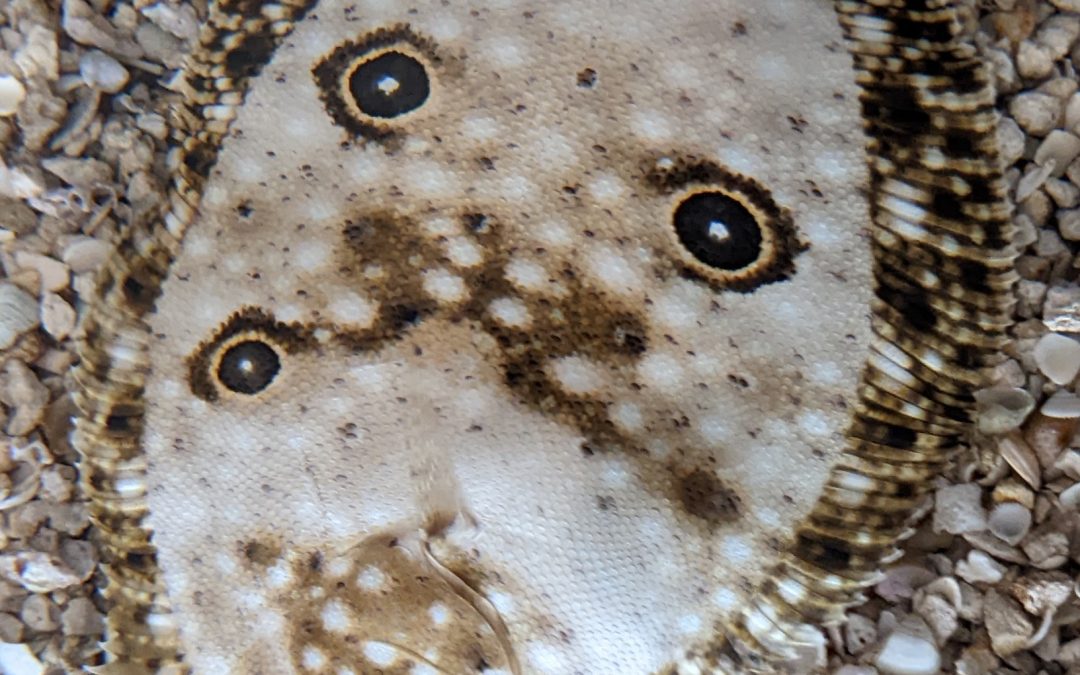
by Erik Lovestrand | Jun 28, 2024
One of several “flatfish” inhabiting our Panhandle coastal waters, the ocellated flounder (Ancylopsetta ommata) is one of the more striking species, in my opinion. From the four distinctive eye spots (ocelli) to its incredible variability in background patterns, I must just say that it is a beautiful creature. Flounders are unique among fish, in that early during larval development one eye will migrate over to join the other and the fish will orient to lay on its side when at rest. Only the top side will have coloration and the bottom side will be white. While the eyes end up on the same side, the pectoral and pelvic fins remain in their traditional positions, although the bottom-side pectoral fin is reduced in size.
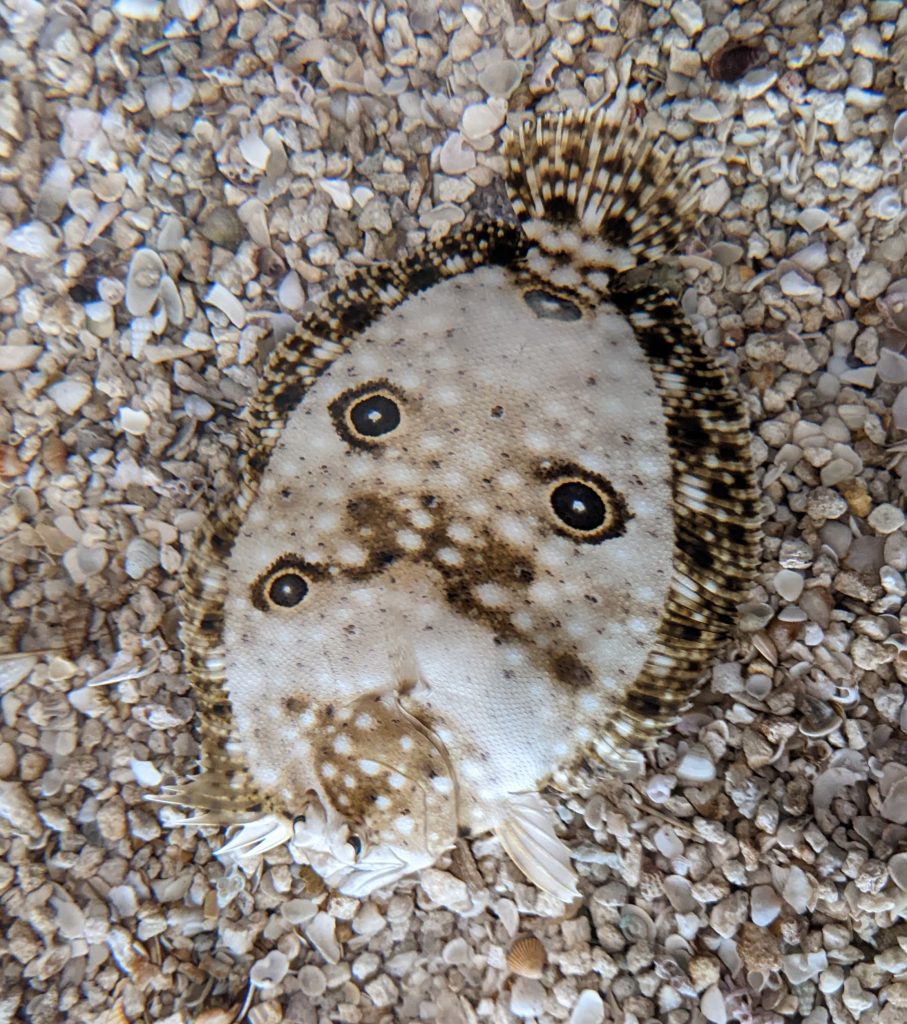
Not the Biggest but Definitely one of the Coolest Flounder Species Around
Ocellated flounders are always left-eyed, meaning if you stood them up vertically with their pelvic fins down, the left side of the body has the eyes. When laying on the ocean floor, their independently moving eyes can keep a lookout in all directions. However, flounders tend to remain immobile when approached, depending on an awesome ability to camouflage themselves from predators. They can flip sand or gravel onto their top side which hides their outline and their ability to match the color and texture of the surrounding substrate is phenomenal.
This species is a fairly small fish, reaching lengths of about ten inches. However, they are by no means the smallest flatfish around. We also have hogchokers (a member of the sole family, 6-8 in.) and blackcheek tonguefish (to 9 in.). These are dwarfed by the larger Gulf flounder and Southern flounder which are highly prized table fare by fishers along our coasts and can reach sizes that earn them the nickname of “doormat” flounders. Regardless of the species of flounder you observe, it is unquestionably one of the super cool animals we have the privilege of living with here along the North Florida Gulf Coast.



















